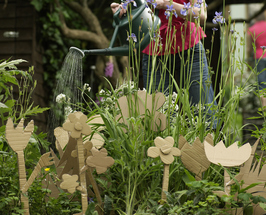
I don’t think I’m the only one.
I know from my studies in the holistic health field and from my work as a life coach and massage therapist that an interesting thing happens when you (and everyone else) feels fear. Fear stimulates the fight or flight response (getting physically ready to face your enemy or run like crazy) and then certain parts of your brain don’t work so well.
When I’m afraid, I can’t think clearly, my logic and reasoning abilities flee like smart critters from a raging wildfire. I know that fear compromises my prefrontal cortex, the executive director/head honcho in my brain. So, instead of making calm, clear decisions, I’m scatterbrained, nervous, and reactive. When I’m afraid, I’m listening to the more primitive part of my brain, the one driven by habits and patterns engraved on my DNA over centuries.
The fight or flight reaction is triggered in various ways, like from …
• Scarcity – When you’re looking at your minuscule bank account balance alongside your bills or when you’re afraid you’ll lose your job and know that there are so few good jobs available;
• Safety – When you or a loved one feels emotionally or physically threatened, like when another driver cuts you off while on the freeway, nearly causing an accident;
• Stress – Which can come from events that may seem insignificant, like feelings of helplessness or loneliness, but can produce a profound fight or flight reaction.
I've seen this response in my children. You might have seen it in your own, too. The prefrontal cortex doesn’t fully develop until a person is in their mid-20s, so toddlers – and teenagers – careen into fight or flight mode quickly. Threaten to take a beloved item away as a consequence for bad behavior – like a toy from a toddler or an iPhone from a teen – and your child's behavior will revert fast and furious into the lower brain, often called the reptilian brain: “That’s mine! I want it! You can’t take it!” Your toddler might react by hitting or biting. Your teen might stomp off to his room and slam the door.
When our brains launch into fight or flight mode, we perceive everything as a threat. It’s similar to Abraham Kaplan’s Law of the Instrument: “Give a small boy a hammer, and he will find that everything he encounters needs pounding.”
The Law of the Instrument, I’ve discovered, works in the opposite way, too: the more actions I take to feel safe, the less safe I feel.
I can’t conquer fear by turning off the television, shutting out what scares me, or hammering down what feels unpredictable and unfamiliar in an attempt to make the world feel less scary. I can only move forward by embracing what I feel.
“I learned that courage was not the absence of fear, but the triumph over it.” ~ Nelson Mandela
Taylor’s research, which she wrote about in her book The Tending Instinct: Women, Men, and the Biology of Nurturing, describes how women are more likely to respond to stress by nurturing the people around them (tending), and by building and supporting their community (befriending). Soothing children, calling a close friend, or offering to help a relative in need are ways women tend and befriend when stressed. These behaviors release the hormone oxytocin (called the love hormone because it increases the feelings of bonding and connectedness) which counteracts the flight or flight response, eases fearfulness, and reduces the negative consequences of ongoing stress.
In times of fear that drive us to fight or flee, we need to have the courage to tend and befriend, to love and rise above fear.
“Be soft,” writes Iain Thomas, the bestselling author of I Wrote This For You. “Do not let the world make you hard. Do not let pain make you hate. Do not let the bitterness steal your sweetness. Take pride that even though the rest of the world may disagree, you still believe it to be a beautiful place.”
By tending to your corner of this world, you do more than believe in its beauty. You make it so.

 RSS Feed
RSS Feed